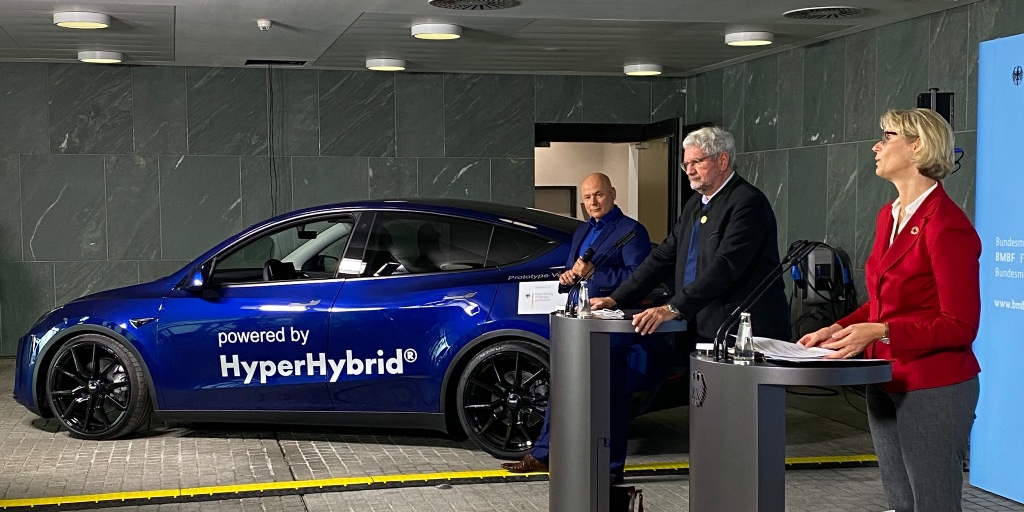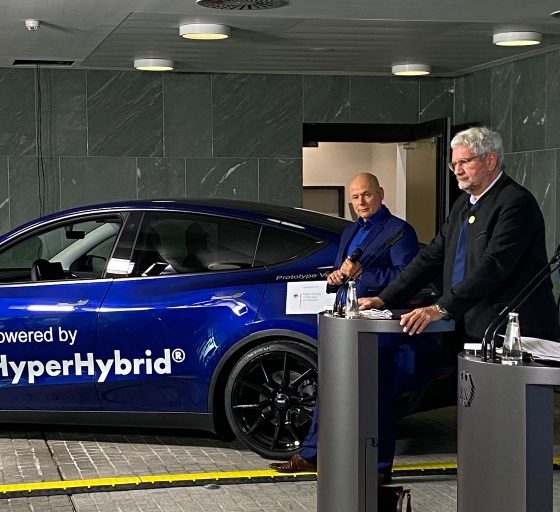

News
Tesla Model Y converted into green hydrogen car to show “Hyper Hybrid” innovations
German Federal Research Minister Anja Karliczek recently unveiled an example of a “hyper hybrid” vehicle powered by synthetic methanol, which is based on “green hydrogen” technologies. But while the idea to produce a climate-friendly car is admirable, the vehicle Germany used for the project was quite questionable. This was because the Federal Research Minister’s team opted to use a Tesla Model Y — an all-electric vehicle that is, in many ways, already the pinnacle for efficiency and sustainability — for the project.
Simply put, Germany took a perfectly working battery-electric vehicle, modified it with a synthetic methanol engine, and dubbed it as a work of true innovation. Karliczek, for his part, noted in a press release that such a project is incredibly important since “green hydrogen” is a valuable building block for climate protection.
“Climate protection can only succeed with green hydrogen. That’s why we are already providing massive support for research into the use of green hydrogen, although efforts will have to be stepped up again in the coming years. Especially in industry and transportation, we will continue to need chemical energy sources in the future. Not all industrial processes can be completely decarbonized. CO2 will continue to be produced. We need solutions for this.
“Today we are building a very interesting bridge between these two points: The use of methanol from ‘recycled’ CO2 from industry as a fuel in road transport… But the methanol car itself is also an ‘innovation showcase’ for low-emission, resource- and energy-efficient mobility of tomorrow. Synthetic fuels have an important role to play in making a sustainable, climate-friendly mobility system possible worldwide. This is important in shipping and air travel, or where a charging station for the electric car may not always be available in the future. Especially there, the serial hybrid drive can be a good solution in perspective,” the Federal Research Minister said.
Speaking about the hybrid Model Y project, Prof. Robert Schlögl, Director of the Max Planck Institute for Chemical Energy Conversion and Carbon2Chem project coordinator, noted that the hybrid technologies used in the initiative present a great synergy between two systems: the efficient electric drivetrain and the easily accessible synthetic fuel methanol.
“The urgency of climate protection requires a rapid and comprehensive entry into renewable energy. In a global market for renewable energy, carbon-based energy sources such as methanol are key building blocks. The serial hybrid drive concept presented here combines the advantages of the efficient electric drive and the energy-dense and easily accessible synthetic fuel methanol. This concept must be further optimized by the research project presented here,” the professor said.
The hybrid Tesla Model Y is part of the Carbon2Chem initiative, which aims to reduce CO2 emissions in the steel industry. The vehicle is a concept built to showcase how methanol is recycled. The Obrist DE GmbH worked with the Technical University of Munich, the Technical University of Dresden, and the RWTH Aachen to create the vehicle. About 10 million euros were estimated to have been spent on the methanol-powered Tesla Model Y. That being said, OBRIST Group CEO Frank Wolf remained proud of the project’s end result.
“Our HyperHybrid powertrain, whose zero-vibration generator produces electricity with green methanol, is an essential innovation for globally deployable, efficient, and emission-neutral e-mobility – in other words, a car with green liquid electricity in the tank!” Wolf said.
Don’t hesitate to contact us with account tips. Just send a message to tips@teslarati.com to give us a heads up.

News
Tesla (TSLA) receives “Buy” rating and $551 PT from Canaccord Genuity
He also maintained a “Buy” rating for TSLA stock over the company’s improving long-term outlook, which is driven by autonomy and robotics.

Canaccord Genuity analyst George Gianarikas raised his Tesla (NASDAQ:TSLA) price target from $482 to $551. He also maintained a “Buy” rating for TSLA stock over the company’s improving long-term outlook, which is driven by autonomy and robotics.
The analyst’s updated note
Gianarikas lowered his 4Q25 delivery estimates but pointed to several positive factors in the Tesla story. He noted that EV adoption in emerging markets is gaining pace, and progress in FSD and the Robotaxi rollout in 2026 represent major upside drivers. Further progress in the Optimus program next year could also add more momentum for the electric vehicle maker.
“Overall, yes, 4Q25 delivery expectations are being revised lower. However, the reset in the US EV market is laying the groundwork for a more durable and attractive long-term demand environment.
“At the same time, EV penetration in emerging markets is accelerating, reinforcing Tesla’s potential multi‑year growth runway beyond the US. Global progress in FSD and the anticipated rollout of a larger robotaxi fleet in 2026 are increasingly important components of the Tesla equity story and could provide sentiment tailwinds,” the analyst wrote.
Tesla’s busy 2026
The upcoming year would be a busy one for Tesla, considering the company’s plans and targets. The autonomous two-seat Cybercab has been confirmed to start production sometime in Q2 2026, as per Elon Musk during the 2025 Annual Shareholder Meeting.
Apart from this, Tesla is also expected to unveil the next-generation Roadster on April 1, 2026. Tesla is also expected to start high-volume production of the Tesla Semi in Nevada next year.
Apart from vehicle launches, Tesla has expressed its intentions to significantly ramp the rollout of FSD to several regions worldwide, such as Europe. Plans are also underway to launch more Robotaxi networks in several more key areas across the United States.
News
Waymo sues Santa Monica over order to halt overnight charging sessions
In its complaint, Waymo argued that its self-driving cars’ operations do not constitute a public nuisance, and compliance with the city’s order would cause the company irreparable harm.

Waymo has filed a lawsuit against the City of Santa Monica in Los Angeles County Superior Court, seeking to block an order that requires the company to cease overnight charging at two facilities.
In its complaint, Waymo argued that its self-driving cars’ operations do not constitute a public nuisance, and compliance with the city’s order would cause the company irreparable harm.
Nuisance claims
As noted in a report from the Los Angeles Times, Waymo’s two charging sites at Euclid Street and Broadway have operated for about a year, supporting the company’s growing fleet with round-the-clock activity. Unfortunately, this has also resulted in residents in the area reportedly being unable to sleep due to incessant beeping from self-driving taxis that are moving in and out of the charging stations around the clock.
Frustrated residents have protested against the Waymos by blocking the vehicles’ paths, placing cones, and “stacking” cars to create backups. This has also resulted in multiple calls to the police.
Last month, the city issued an order to Waymo and its charging partner, Voltera, to cease overnight operations at the charging locations, stating that the self-driving vehicles’ activities at night were a public nuisance. A December 15 meeting yielded no agreement on mitigations like software rerouting. Waymo proposed changes, but the city reportedly insisted that nothing would satisfy the irate residents.
“We are disappointed that the City has chosen an adversarial path over a collaborative one. The City’s position has been to insist that no actions taken or proposed by Waymo would satisfy the complaining neighbors and therefore must be deemed insufficient,” a Waymo spokesperson stated.
Waymo pushes back
In its legal complaint, Waymo stated that its “activities at the Broadway Facilities do not constitute a public nuisance.” The company also noted that it “faces imminent and irreparable harm to its operations, employees, and customers” from the city’s order. The suit also stated that the city was fully aware that the Voltera charging sites would be operating around the clock to support Waymo’s self-driving taxis.
The company highlighted over one million trips in Santa Monica since launch, with more than 50,000 rides starting or ending there in November alone. Waymo also criticized the city for adopting a contentious strategy against businesses.
“The City of Santa Monica’s recent actions are inconsistent with its stated goal of attracting investment. At a time when the City faces a serious fiscal crisis, officials are choosing to obstruct properly permitted investment rather than fostering a ‘ready for business’ environment,” Waymo stated.
News
Tesla FSD v14.2.2 is getting rave reviews from drivers
So far, early testers have reported buttery-smooth drives with confident performance, even at night or on twisty roads.

Tesla Full Self-Driving (Supervised) v14.2.2 is receiving positive reviews from owners, with several drivers praising the build’s lack of hesitation during lane changes and its smoother decision-making, among others.
The update, which started rolling out on Monday, also adds features like dynamic arrival pin adjustment. So far, early testers have reported buttery-smooth drives with confident performance, even at night or on twisty roads.
Owners highlight major improvements
Longtime Tesla owner and FSD user @BLKMDL3 shared a detailed 10-hour impression of FSD v14.2.2, noting that the system exhibited “zero lane change hesitation” and “extremely refined” lane choices. He praised Mad Max mode’s performance, stellar parking in locations including ticket dispensers, and impressive canyon runs even in dark conditions.
Fellow FSD user Dan Burkland reported an hour of FSD v14.2.2’s nighttime driving with “zero hesitations” and “buttery smooth” confidence reminiscent of Robotaxi rides in areas such as Austin, Texas. Veteran FSD user Whole Mars Catalog also demonstrated voice navigation via Grok, while Tesla owner Devin Olsen completed a nearly two-hour drive with FSD v14.2.2 in heavy traffic and rain with strong performance.
Closer to unsupervised
FSD has been receiving rave reviews, even from Tesla’s competitors. Xpeng CEO He Xiaopeng, for one, offered fresh praise for FSD v14.2 after visiting Silicon Valley. Following extended test drives of Tesla vehicles running the latest FSD software, He stated that the system has made major strides, reinforcing his view that Tesla’s approach to autonomy is indeed the proper path towards autonomy.
According to He, Tesla’s FSD has evolved from a smooth Level 2 advanced driver assistance system into what he described as a “near-Level 4” experience in terms of capabilities. While acknowledging that areas of improvement are still present, the Xpeng CEO stated that FSD’s current iteration significantly surpasses last year’s capabilities. He also reiterated his belief that Tesla’s strategy of using the same autonomous software and hardware architecture across private vehicles and robotaxis is the right long-term approach, as it would allow users to bypass intermediate autonomy stages and move closer to Level 4 functionality.








